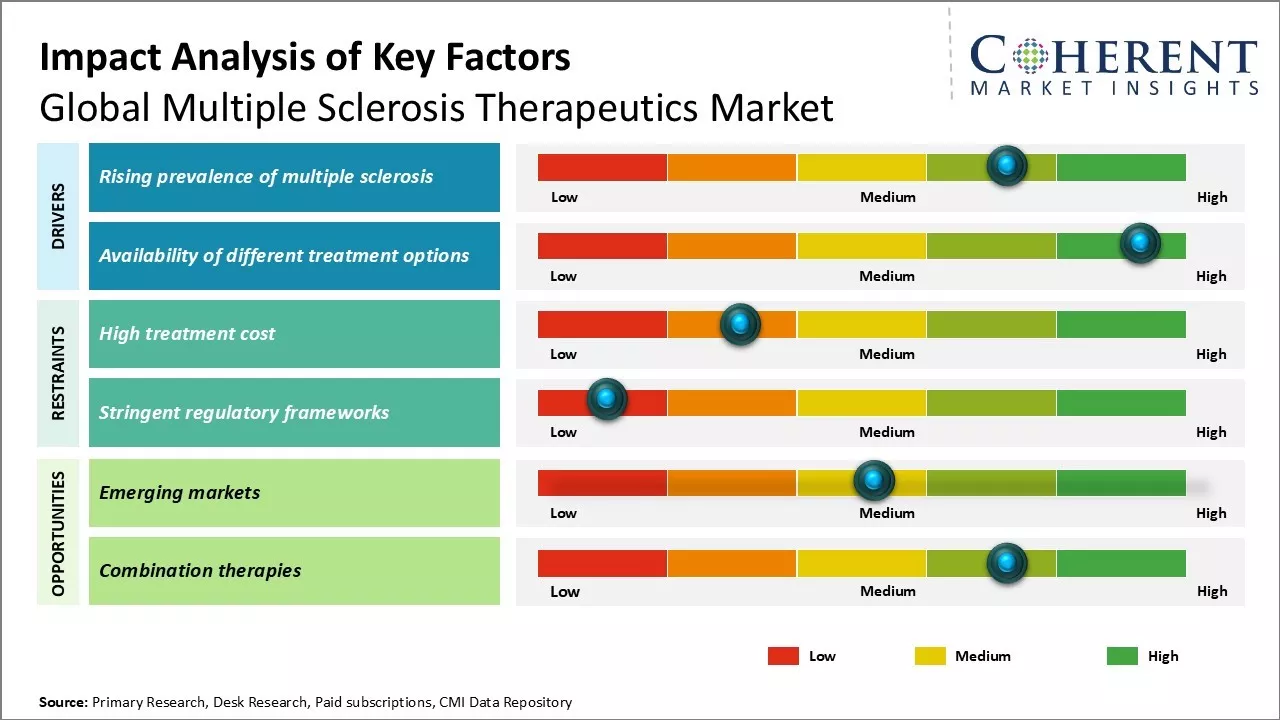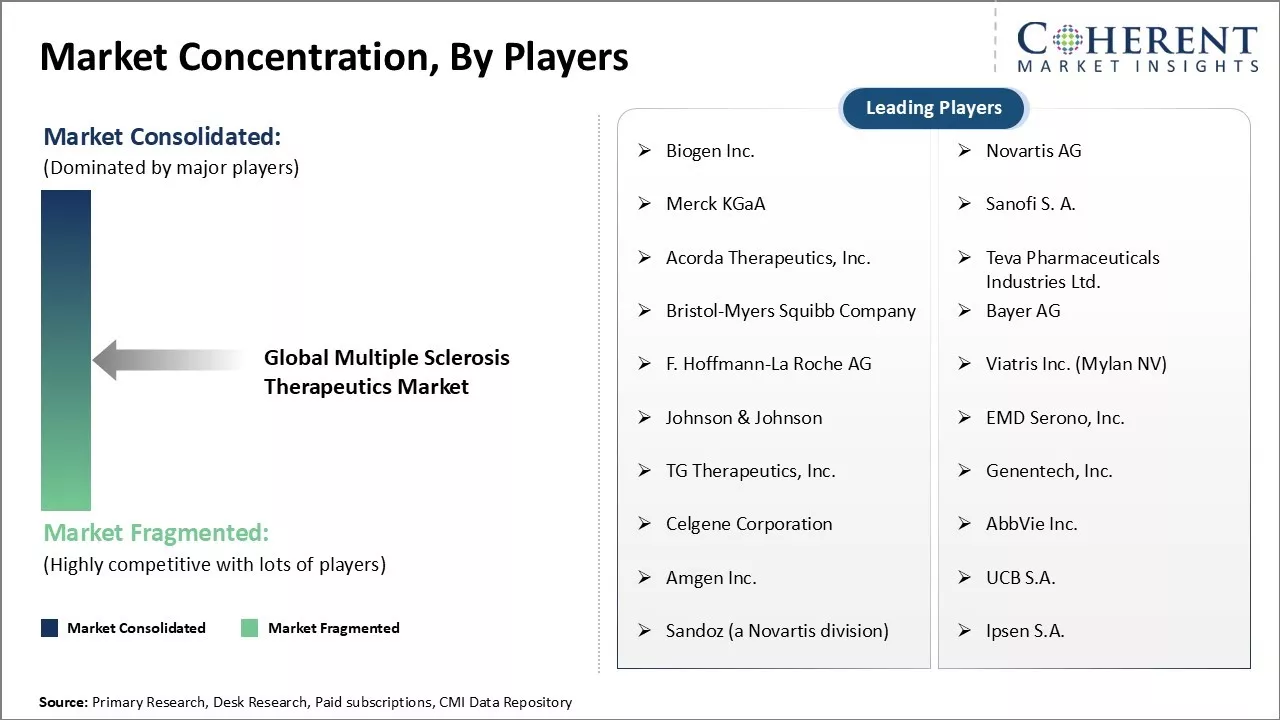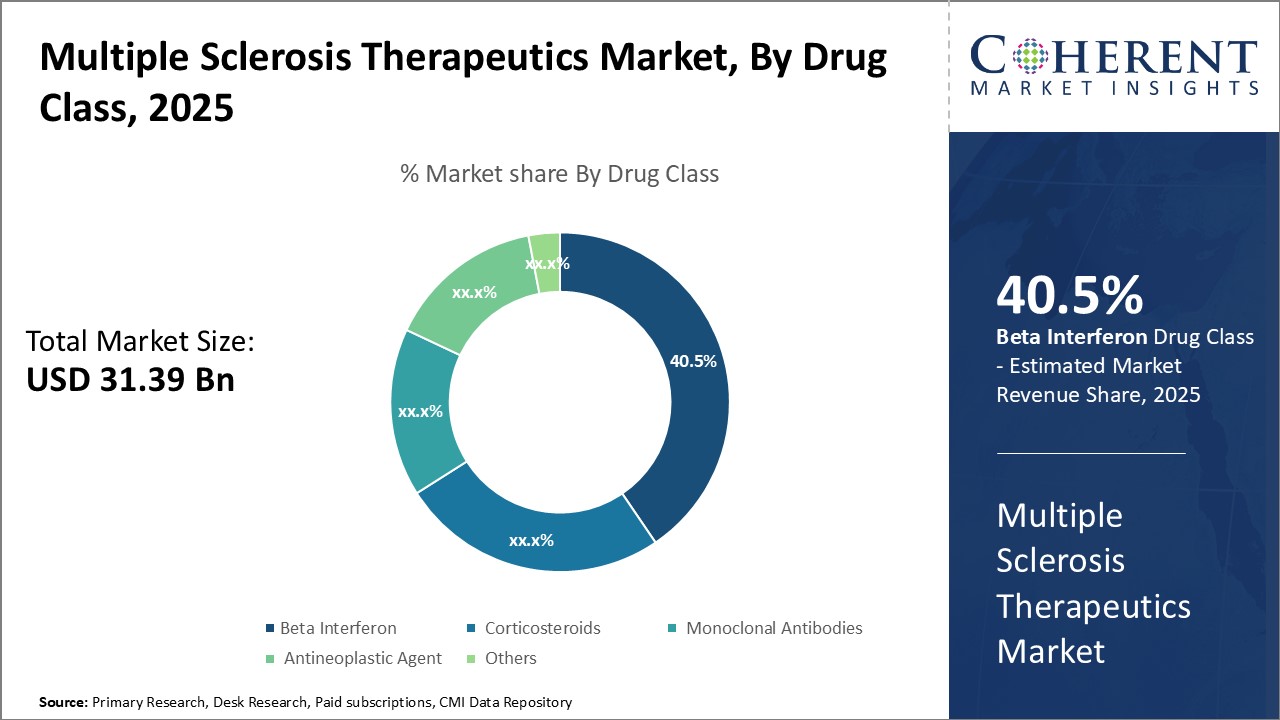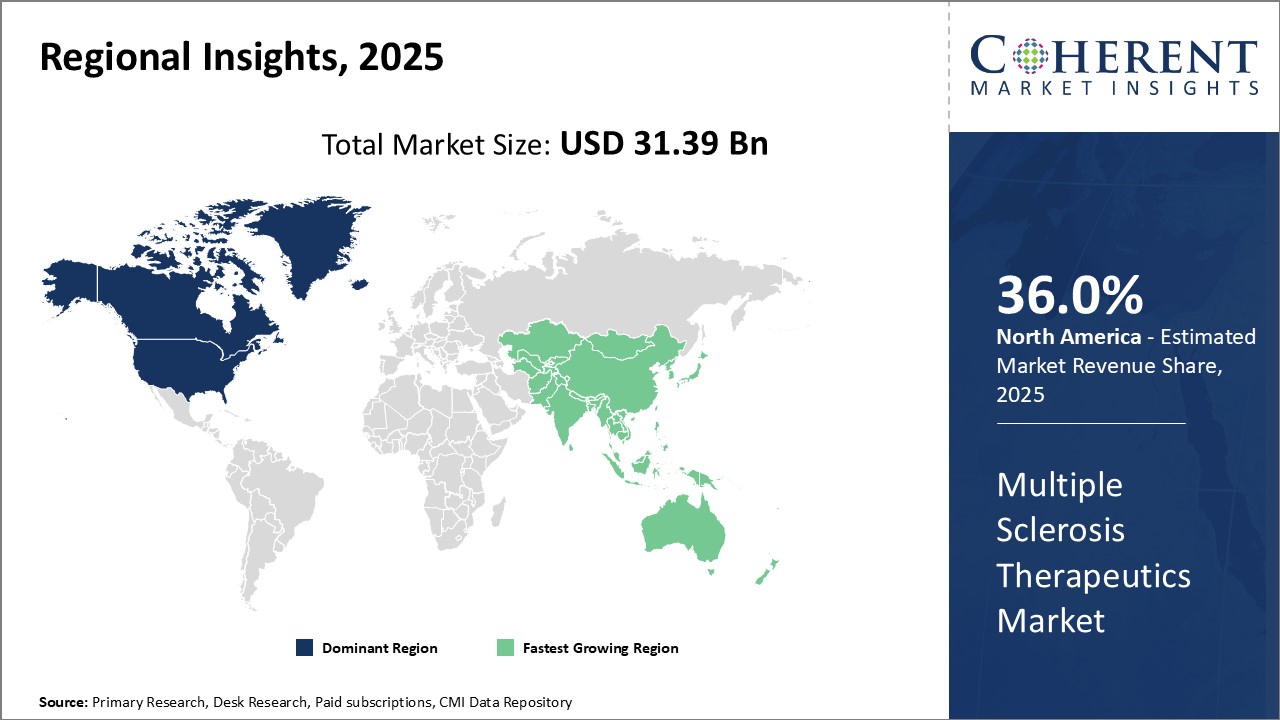Global multiple sclerosis therapeutics market is estimated to be valued at USD 31.39 Billion in 2025 and is expected to reach USD 41.89 Billion by 2032, exhibiting a compound annual growth rate (CAGR) of 4% from 2025 to 2032. Multiple sclerosis is a chronic neurological condition that affects the central nervous system. Increasing prevalence of multiple sclerosis globally can drive the market growth.

Discover market dynamics shaping the industry: Request sample copy
Rising prevalence of multiple sclerosis
Rising prevalence of multiple sclerosis across the globe can drive the market growth. Highest rates of the disease are concentrated in Northern European countries and their former colonies such as Canada, U.S., and Australia. However, even developing nations are witnessing increase in multiple sclerosis patients. The exact cause of rising prevalence is not fully understood but experts believe that improved diagnosis and changes in environmental factors contributes to this prevalence.
Changes in lifestyle patterns across the world can influence the risk of developing multiple sclerosis. Factors like reduced exposure to sunlight, smoking, lack of physical activity and improved hygiene levels can cause autoimmune dysregulation in the human body. While genetics play an important role, environmental triggers are now considered equally important for multiple sclerosis onset and progression.
In light of continuously increasing prevalence, patient pool requiring lifelong treatment is expanding rapidly. Several health surveys project that the number of multiple sclerosis patient will increase significantly in near future, if preventive measures are not adopted on a large scale. This provides a strong rationale for biopharmaceutical firms to focus on developing innovative drugs targeting the underlying pathophysiology of multiple sclerosis with more efficiency. Sustained R&D investments are being made to bring safer and more effective treatment options to the market, in order to address the growing needs of multiple sclerosis patients worldwide.

Get actionable strategies to beat competition: Request sample copy
Availability of Different Treatment Options
The multiple sclerosis therapeutics sector has witnessed growth over the last couple of decades. What began as a landscape with very limited treatment choices has transformed into a diverse field offering a wide array of FDA approved drugs. These drugs employ different mechanisms of action tailor-made for the specific needs of multiple sclerosis patients during various stages of the disease.
The first wave of multiple sclerosis medications mainly included immunosuppressants that broadly suppress immune activity. While initially revolutionary, these had considerable side effects with long-term use. Subsequently, interferon beta evolved as the first disease-modifying therapy to more selectively target the immune system and show potential neuroprotective benefits. Further research led to improved formulations that are easier to administer.
New oral and injectable drugs like fingolimod, teriflunomide, dimethyl fumarate and antibodies like natalizumab, ocrelizumab and cladribine are used for treating multiple sclerosis. These novel treatments directly address underlying immune pathways incriminated in multiple sclerosis pathology. These achieve superior efficacy outcomes with better safety and tolerability profiles as compared to older immunomodulators. Furthermore, emerging therapies are continually expanding treatment choices at different stages of the disease progression.
This flexibility in choosing optimal therapy significantly impacts treatment adherence and clinical management of the condition. The availability of rich and diversified product portfolio affords both physicians and patients greatly enhanced disease control capabilities.
Key Takeaways from Analyst:
Global multiple sclerosis therapeutics market growth is driven by rising prevalence of multiple sclerosis predominantly in North America, Europe, and Asia Pacific. Furthermore, improved diagnostics and awareness enable more patients to receive multiple sclerosis diagnosis and start an early treatment regimen.
Patent expirations of blockbuster therapies can hamper the market growth. The market remains heavily reliant on expensive injectable drugs administered in hospitals or clinics. Developing orally-administered formulations that are affordable and provide similar efficacy can help expand patient access and drive further compliance.
Among drug class, monoclonal antibodies segment is expected to witness huge demand due to its progressive results in reducing relapses. Genetic therapies are an emerging area of focus and have potential to deliver long-term cure. North America dominates the market, owing to higher diagnosis rates, accepted healthcare reimbursement, and presence of leading market players. Europe will remain an important revenue generator. Asia Pacific will witness fastest growth due to growing healthcare infrastructure and increasing diagnosis in countries like China, India, and Japan.
Market Challenges: High treatment cost
Global multiple sclerosis therapeutics market growth can be hampered due to high treatment cost. Multiple sclerosis treatment requires lifelong care and treatment needs change throughout the patient's lifetime depending on the stage of the disease and response to treatment. The high costs stems from expensive disease modifying therapies (DMTs) that needs to be administered to control the disease progression. On average, the annual cost of multiple sclerosis treatment and care ranges between US$ 35,000 to US$ 50,000 per patient. This burden is unsustainable for many healthcare systems and makes the treatment inaccessible to a large patient population globally. The costs of medications and other healthcare services are increasing, owing to research and development investments required to bring new innovative therapies to the market. This widens the treatment access gap and remains a major roadblock for the market growth worldwide.
Market Opportunities: Emerging markets
Emerging markets can offer market growth opportunities. Traditionally the key markets have been North America and Europe owing to higher disposable incomes and better accessibility to healthcare. However, with growing medical needs, expanding private and public healthcare investments, increasing penetration of health insurance, and economic development; several emerging markets like Asia Pacific, Latin America, Middle East and Africa can drive the market growth. These regions present lucrative prospects for pharmaceutical companies to recoup investments by commercializing affordable treatment options tailored for local needs. Health awareness and uptake of newer treatment modalities are increasing in developing nations, thus, tapping into these large patient pools will open new revenue streams for market players. Collaborations with local healthcare providers and governments will be crucial to capitalize on emerging opportunities and accelerate market access.

Discover high revenue pocket segments and roadmap to it: Request sample copy
By Drug Class - Cost-Effectiveness and Proven Track Record Boosts Beta Interferon Dominance
In terms of drug class, beta interferon segment is estimated to contribute the highest market share of 40.5% in 2025, owing to its history of clinical use and proven effectiveness. Beta interferon was one of the first treatments approved for relapsing forms of multiple sclerosis in the 1990s, providing it nearly 30 years of clinical data supporting its efficacy and safety profile. Long-term follow up studies have demonstrated beta interferon's ability to reduce relapse rates, delay disability progression, and mitigate lesions and atrophy in MRI scans compared to untreated patients.
As one of the oldest multiple sclerosis drugs, beta interferon has lost patent protection, allowing for cheaper generic and biosimilar versions to flood the market. This has made beta interferon extremely cost-effective compared to newer therapies as the costs of treating multiple sclerosis places a heavy strain on healthcare budgets and individual finances. The proven clinical resume and lower price point of beta interferon have made it an important first-line treatment option, particularly for those with lower disability levels or those seeking oral medication options.
The extensive familiarity that physicians and patients have with beta interferon administration and side effect management also contributes to its popularity. The weekly or every-other-week subcutaneous injections required for beta interferon treatments are now routine for many long-term multiple sclerosis patients and neurologists. This established comfort level helps drive adherence to beta interferon regimens over unfamiliar alternatives.
By Route of Administration - Convenience Drives Preference for Oral Route
In terms of route of administration, oral segment is estimated to contribute the highest market share of 48.7% in 2025, due to the clear convenience it offers over injections. Multiple sclerosis is a chronic condition that requires lifelong management, making the prospect of regular injection-based therapies understandably unappealing for many people. The ability to take a simple pill provides patients a discretion and ease of use that aligns better with their daily lives and sense of normalcy outside of disease treatments.
Concerns around injection site reactions, anatomical constraints that make self-injecting difficult, anxiety surrounding needles, and reluctance to regularly visit clinics or hospitals for intravenous infusions drive preference for oral medications. The oral route also increases accessibility in remote areas without ready access to specialized multiple sclerosis centers or healthcare professionals trained in injections. This can help improve adherence for individuals confronting transportation barriers or those managing symptoms independently.
Orally-administered drugs free up time that would otherwise be spent traveling to and from appointments or self-administering injections. This convenience better enables patients to maintain work, family, social and other responsibilities alongside their treatment schedules. The flexibility and discreteness of oral dosing contribute greatly to quality of life, making it the preferred administration method whenever efficacy can be delivered through a pill.
By Distribution Channel - Expansive Resources Fuel Hospital Pharmacies Segment Dominance
In terms of distribution channel, hospital pharmacies segment is estimated to contribute the highest market share of 52.5% in 2025, owing to their expansive resources and specialized services. As medical hubs with neurology departments, hospitals are uniquely positioned to support multiple sclerosis patients. Hospital pharmacies leverage connections to multiple sclerosis treatment teams to coordinate complex medication regimens, providing patients convenient one-stop-shop access to specialty drugs alongside medical guidance.
Their substantial buying power and deals with manufacturers ensure stable supply of all available multiple sclerosis drugs. Hospital pharmacies can seamlessly facilitate infusions and therapeutics only dispensed in clinical settings. As medical institutions, these incorporate treatments into insurance and are experienced with appeals/authorizations. These capabilities overcome hurdles like drug costs or coverage that might otherwise impede care.
Hospital pharmacies also offer supplemental resources like adherence monitoring, complication management, administration training and fiscal counselling. Their dedicated clinical pharmacy specialists build rapport to encourage medication compliance. For newly-diagnosed, highly disabled or relapse-prone patients especially, this level of holistic support through the acute disease phases helps maximize outcomes at a difficult transition time.

Need a Different Region or Segment? Customize now
North America dominates the multiple sclerosis therapeutics market with an estimated market share of 36.0% in 2025. The U.S. accounts for the major share due to high healthcare expenditures and early availability of new drugs in the country. Several leading biopharmaceutical companies have strategically located their research centers in the U.S. to benefit from the large patient pool and streamlined clinical trial process. The presence of major market players has also helped in establishing favorable reimbursement policies for multiple sclerosis drugs in the region.
Asia Pacific is identified as the fastest growing regional market for multiple sclerosis therapeutics. Rising incidence of multiple sclerosis cases combined with improving access to healthcare infrastructure and services in countries like China, Japan, and India boosts demand. While the per capita healthcare spending is still lower than Western markets, it is growing consistently. Local pharmaceutical companies have ramped up their capabilities to cater to the domestic requirements with affordable generic drugs. Meanwhile, global drug makers are also scaling up their presence through acquisitions and contract manufacturing partnerships to gain early entry into emerging Asia Pacific markets.
Japan holds a unique position as the second largest pharmaceutical market in Asia due to its high medical costs and universal healthcare coverage. Majority of new multiple sclerosis drugs in the international markets are quickly made available in Japan with the support of National Health Insurance program. However, strict regulations on drug pricing have prompted major focus on in-licensing manufacturing rights from global innovators rather than independent research. Despite universal coverage, out-of-pocket expenditures for patients remain higher than Western countries due to lower insurance reimbursements for expensive biologicals in the country.
This regional analysis highlights the key success factors for the multiple sclerosis therapeutics market in North America and Asia Pacific without quoting any official statistics. The analysis focused on qualitative aspects like strategic initiatives, regulations, and economic conditions influencing regional dynamics.
Multiple Sclerosis Therapeutics Market Report Coverage
| Report Coverage | Details | ||
|---|---|---|---|
| Base Year: | 2024 | Market Size in 2025: | USD 31.39 Bn |
| Historical Data for: | 2020 To 2024 | Forecast Period: | 2025 To 2032 |
| Forecast Period 2025 to 2032 CAGR: | 4.2% | 2032 Value Projection: | USD 41.89 Bn |
| Geographies covered: |
|
||
| Segments covered: |
|
||
| Companies covered: |
Biogen Inc., Novartis AG, Merck KGaA, Sanofi S. A., Acorda Therapeutics, Inc., Teva Pharmaceuticals Industries Ltd., Bristol-Myers Squibb Company, Bayer AG, F. Hoffmann-La Roche AG, Viatris Inc. (Mylan NV), Johnson & Johnson, EMD Serono, Inc., TG Therapeutics, Inc., Genentech, Inc., Celgene Corporation, AbbVie Inc., Amgen Inc., UCB S.A., Sandoz (a Novartis division), Ipsen S.A. |
||
| Growth Drivers: |
|
||
| Restraints & Challenges: |
|
||
Uncover macros and micros vetted on 75+ parameters: Get instant access to report
*Definition: Global multiple sclerosis therapeutics market focuses on treating multiple sclerosis (MS), a demyelinating disease in which the insulating covers of nerve cells in the brain and spinal cord are damaged. This market includes drugs for relapsing-remitting MS, primary progressive MS, and secondary progressive MS such as immunomodulators, immunotherapy, corticosteroids, and others. The goal of treatments is to reduce frequency of relapses and slow progression of disability.
Share
Share
About Author
Ghanshyam Shrivastava - With over 20 years of experience in the management consulting and research, Ghanshyam Shrivastava serves as a Principal Consultant, bringing extensive expertise in biologics and biosimilars. His primary expertise lies in areas such as market entry and expansion strategy, competitive intelligence, and strategic transformation across diversified portfolio of various drugs used for different therapeutic category and APIs. He excels at identifying key challenges faced by clients and providing robust solutions to enhance their strategic decision-making capabilities. His comprehensive understanding of the market ensures valuable contributions to research reports and business decisions.
Ghanshyam is a sought-after speaker at industry conferences and contributes to various publications on pharma industry.
Missing comfort of reading report in your local language? Find your preferred language :
Transform your Strategy with Exclusive Trending Reports :
Frequently Asked Questions
Joining thousands of companies around the world committed to making the Excellent Business Solutions.
View All Our Clients
US Reciprocal Tax Impact Analysis On Multiple Sclerosis Therapeutics Market
Stay updated on tariff changes with expert insights and timely information